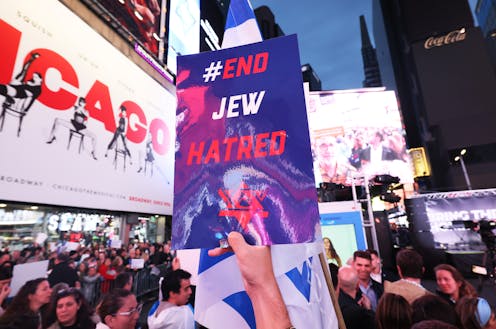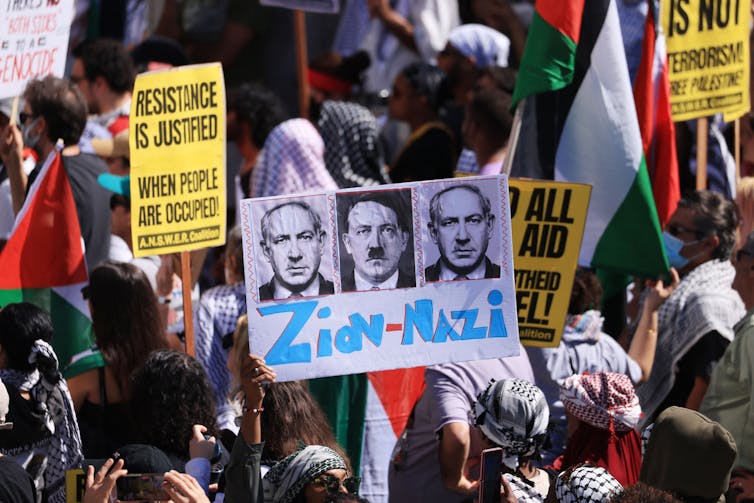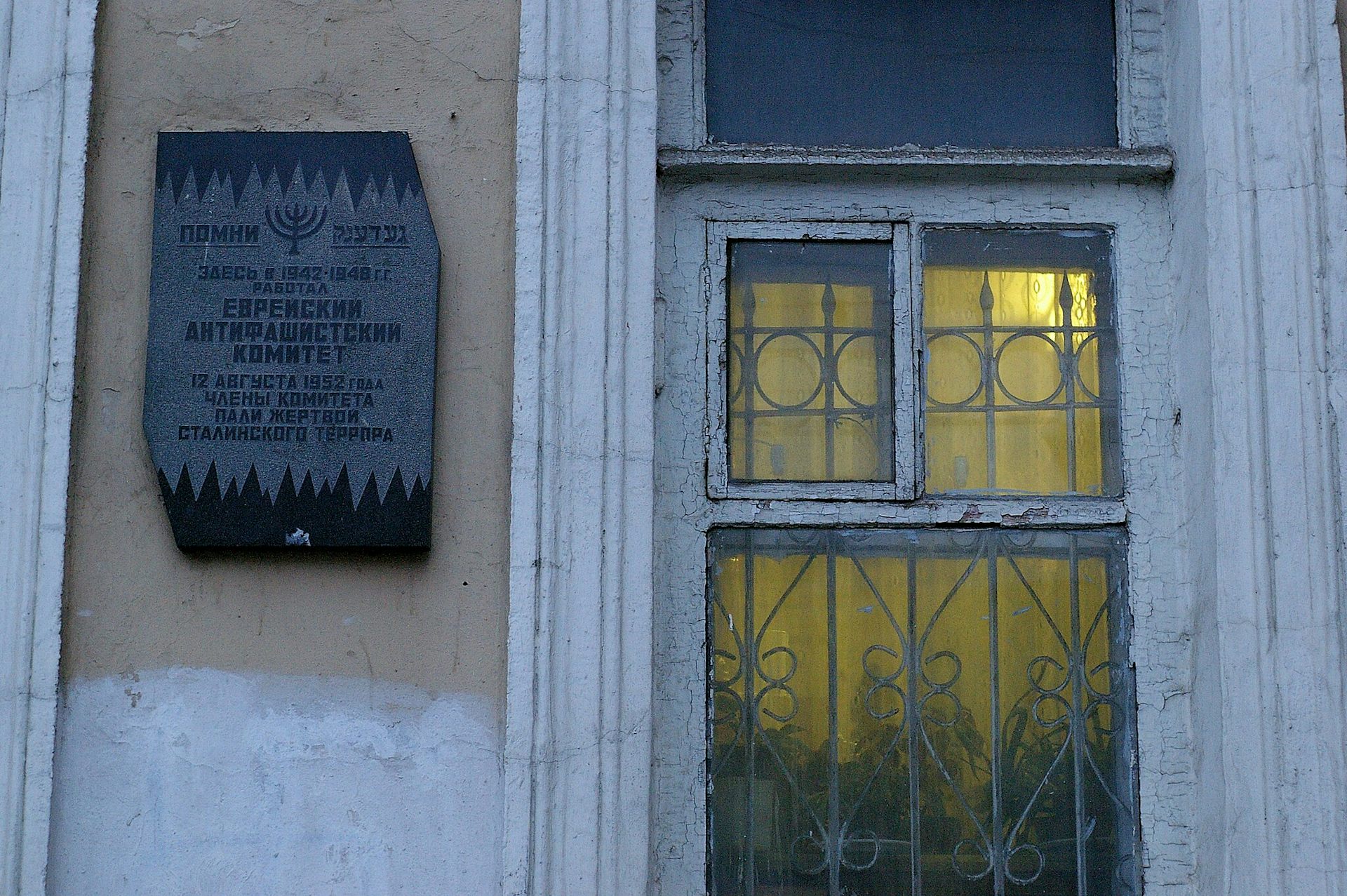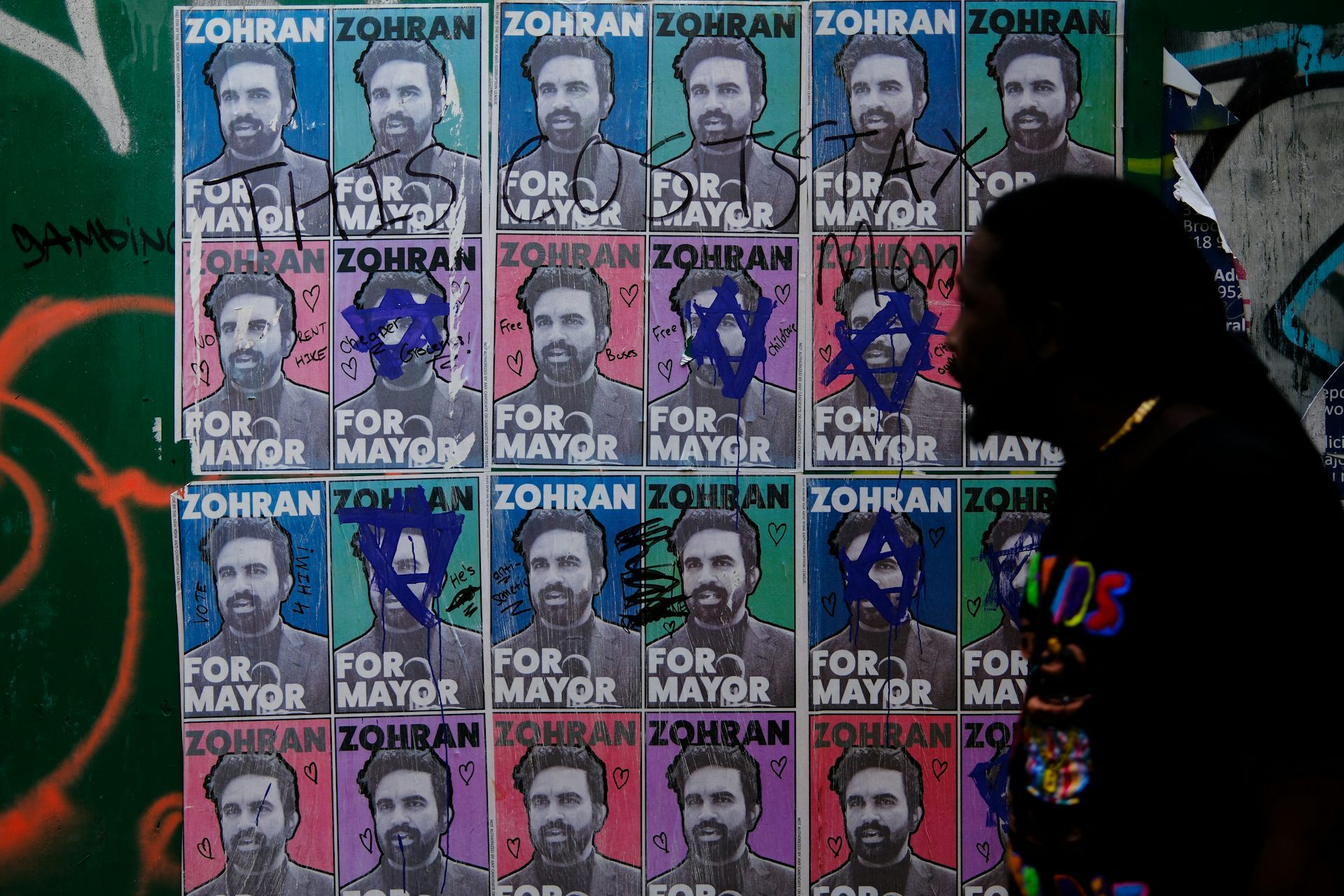Antisemitism has moved from the right to the left in the US − and falls back on long-standing stereo
Antisemitism in the US is growing – and that growth appears to be related to the escalation of the conflict between Israel and Hamas. It also reflects a different political ideology than in the past.

The U.S. is currently experiencing one of the most significant waves of antisemitism that it has ever seen. Jewish communities are shaken and traumatized.
Jewish and civil rights organizations both in the U.S. and in other Western countries reported a rise in antisemitic incidents following the Oct. 7, 2023, Hamas attack on Israel and the subsequent Israeli military response. The Anti-Defamation League reported that in the first week after Hamas’ deadly attack, in which 1,400 Israelis were killed, antisemitic incidents in the U.S. tripled in comparison to the same week last year.
Similarly, London police recorded a 1,353% increase in antisemitic crimes compared with the same period a year earlier.
In addition, antisemitic symbols and rhetoric seem to be part of a growing number of protests that erupted around the globe following the escalation of the conflict between Israel and Hamas.
Most scholars agree that the term “antisemitism” describes animosity and discrimination against Jews. Broader definitions, such as the one adopted by the International Holocaust Remembrance Alliance, include the singling out of Israel and the demonization of its character, such as the claim that “the existence of a State of Israel is a racist endeavor.”
My team of researchers at UMass Lowell and Development Service Group, a Washington, D.C.-based think tank, compiled and analyzed a comprehensive dataset of antisemitic incidents in the U.S. between 1990 and 2021. We wanted to understand what factors led to antisemitism. We covered violent antisemitism as well as incidents of antisemitic intimidation and vandalism. We included any attacks against Jews which were motivated by the religious identity of the victims – even if it was motivated by anger about Israeli policies.
Our study, which will be published soon, found a startling new phenomenon: The ideology underlying antisemitism in the U.S. now encompasses both sides of the political spectrum. And it allowed us to develop three other insights regarding the intensifying linkage between the Israeli-Palestinian conflict and antisemitism in the U.S.
1. Antisemitism is not exclusive to the far right
Traditionally, antisemitism in the United States was promoted by far-right organizations and movements, such as the Ku Klux Klan, neo-Nazi groups and skinheads. Such groups focused on propagating traditional antisemitic narratives alleging Jews’ racial inferiority, their control of the financial sector and their role in global cabals aiming to undermine America and Western civilization.
More recently, progressive and left-leaning movements that are critical of Israel’s policies – especially with regard to the Palestinian population in the territories occupied by Israel in 1967 – have become linked to antisemitic practices, too.
In a survey conducted in 2018 in 12 European Union countries among victims of antisemitism, 21% indicated that they were physically or verbally attacked by what participants called “left-wing” activists. In the U.S., our data shows that 95% of antisemitic incidents motivated by Israel’s policies were perpetrated by far-left or unidentified activists. Just 5% were perpetrated by known far-right activists.
Further indication that antisemitic violence is no longer the sole domain of far-right extremists can be gleaned from an analysis of our data that looked at the geographic characteristics of antisemitism.
We find that antisemitic hate crimes are occurring especially in politically progressive areas of the country. The New York metropolitan area and the Northeast in general, and urban centers in Florida, California, the Northwest and the Midwest are experiencing the majority of antisemitic incidents.
While these regions of the U.S. were usually considered hospitable to minorities, our data reflects that in the past decade they are the most substantial hubs of antisemitic violence.
2. US antisemitism is strongly correlated to escalation in the Israeli-Palestinian conflict
The outbreak of violence between Israel and Palestinians seems to inflame antisemitism in the U.S. and is exploited to amplify long-standing antisemitic tropes.
Rigorous analysis of our dataset found conclusive evidence that these escalations in the Israeli-Palestinian conflict – such as the violent clashes between Hamas and Israel in the Gaza Strip in the past few years – are accompanied by an increase in antisemitic incidents in the U.S.
For example, in the months leading up to the Israel-Hamas war of May 2021, there was a gradual increase in antisemitic attacks that peaked in May 2021 and gradually declined in the following months.
3. Israel’s policies and antisemitism abroad are connected
The growing connection between Israel’s policies and antisemitic violence abroad, and especially in the U.S., reflects the view among many Americans that American Jews unquestioningly support Israel’s government.
The Anti-Defamation League’s leader put it bluntly when he stated following the May 2021 Israel-Hamas war that “the violence we witnessed in America during the conflict last May was shocking … it seemed as if the working assumption was that if you were Jewish, you were blameworthy for what was happening half a world away.”
Thus, it is not surprising that following the Oct. 7, 2023, Hamas attack, Jewish organizations on American campuses became the main targets of violent activism by Palestinian rights supporters. Nor was it surprising that the first reaction of U.S. law enforcement agencies in the wake of the Hamas attack was enhancing the protections of Jewish schools and communal facilities.

4. Antisemitism today exploits long-standing antisemitic tropes
American Jewish communities had traditionally strong links to the state of Israel, and many extended their support in various ways. They included contributing money to Israeli cultural, educational and social institutions, as well as advocating for U.S. support. This was explicit acknowledgment of the importance to the Jewish people of having a homeland.
In recent years, however, many Jewish communities, especially their younger members, became increasingly critical of Israeli policies and the country’s ongoing military control of the occupied Palestinian territories.
Despite such developments within the Jewish community, efforts by organizations sympathetic to the Palestinian cause to link American Jews as a whole to Israel’s policies seem to have intensified. Such linkages reflect an extension of one of the most resilient and long-standing antisemitic tropes, in which American Jews are portrayed as having a dual loyalty and a preference to support Israel’s interests over American ones, especially in times in which they may conflict.
In the past, sentiments regarding American Jews’ alleged dual loyalty were mainly exploited by extremists on the far right. Lately, it seems also to be manifested in left-wing discourse and actions that support or legitimize marginalization of Jews in the U.S. by blaming them for Israel’s policies.
Examples of this new manifestation of antisemitism include the exclusion of American Jewish organizations from progressive campaigns and events and the exclusion of Jewish activists from progressive associations.
Combating the new antisemitism
The reactions to the recent escalation in the Israeli-Palestinian conflict illustrate a profound change in the ideological roots of antisemitism in the U.S.
The many cases in which professional and student associations as well as political organizations were quick both to legitimize Hamas terrorist attacks on Israeli civilians and direct their animosity toward U.S. Jews showing solidarity and sympathy with Israeli victims are prime examples.
That means any effort to combat antisemitism in the U.S. must take into consideration the growing ideological diversity behind contemporary incidents of antisemitism.
Those efforts will need to understand the nuances that shape American Jews’ relationships with Israel – and recognize that despite the substantial progress U.S. Jews experienced in the U.S. in all aspects of public life, antisemitism is still a part of the American political landscape.
Arie Perliger receives funding from the National Institute of Justice
Read These Next
Winter storms blanket the East, while the U.S. West is wondering: Where’s the snow?
Here’s what snow forecasters are watching, and why skiers and other snow lovers shouldn’t lose hope.
Rural high school students are more likely than city kids to get their diplomas, but they remain les
1 in 5 students in the US are living in rural areas.
Stalin’s postwar terror targeted Soviet Jews – in the name of ‘anti-cosmopolitanism’
Thirteen Jewish leaders and artists were killed on the ‘Night of the Murdered Poets,’ one of the…





